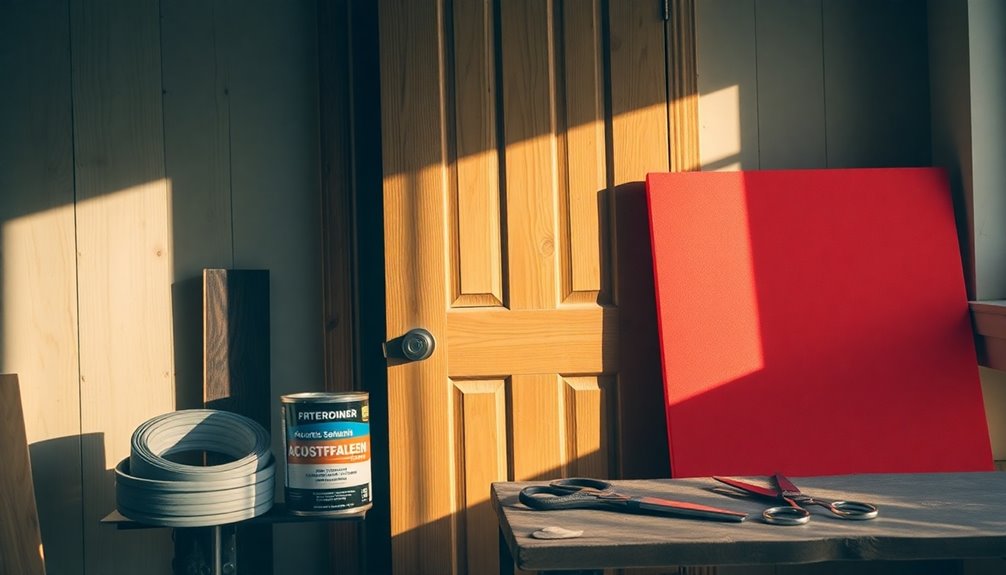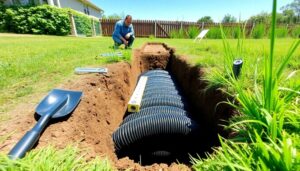To soundproof your doors on a budget, start with essential tools like weather stripping and door sweeps, which seal gaps effectively. Use acoustic caulk to fill cracks and enhance your soundproofing efforts. If you want more mass, consider adding heavy curtains or blankets, which can absorb sound without breaking the bank. For even better results, invest in a door seal kit that seals all four sides and increases insulation by up to 50%. With these budget-friendly solutions, you can reduce noise effectively. Keep exploring to discover even more helpful strategies and materials!
Understanding Soundproofing Basics
When it comes to soundproofing, understanding the basics can make a considerable difference in your results. Soundproofing aims to absorb sound wave energy, and it's key to realize that doors, walls, and floors are critical areas for intervention.
One of the most common issues you'll face is the small gaps around doors. Even a 1% gap can reduce your sound isolation by an astonishing 50%. Using tools like expense tracking tools can help manage your budget effectively while purchasing soundproofing materials. Additionally, many expense tracking apps offer features like receipt scanning that can simplify the management of your soundproofing expenses.
To combat this, consider using a solid core door instead of a hollow core one. Solid core doors offer better sound insulation, with solid wood options achieving Rw values ranging from 25-35, and acoustic doors rated Rw 42+ providing superior sound reduction.
Moreover, you can enhance your soundproofing efforts by sealing gaps around the door. Techniques such as installing door sweeps, weather stripping, and applying acoustic caulk can considerably improve your soundproofing effectiveness. Additionally, utilizing advanced receipt scanning technology can help streamline the process of managing your expenses related to soundproofing materials.
Essential Materials for Soundproofing
To effectively soundproof your doors, you'll need the right materials that enhance sound isolation without overwhelming your space. One of the most effective soundproofing materials is Mass Loaded Vinyl (MLV). This dense, flexible barrier can be applied directly to your door, considerably reducing noise without consuming much space. Additionally, utilizing budgeting apps can aid in managing your expenses as you invest in these materials.
Additionally, consider adding door sweeps to the bottom of your doors. These budget-friendly solutions effectively close the gap between the door and the floor, minimizing noise transmission from outside. Weather stripping is another essential, inexpensive material that seals gaps around your doors, preventing sound leakage and boosting overall sound insulation. Don't forget about acoustic caulk; this specialized sealant is perfect for filling cracks and gaps around door frames, providing an airtight seal that efficiently blocks sound waves.
If you're looking for a more permanent upgrade, swapping out a hollow core door for a solid core one can dramatically improve sound insulation. Solid doors typically have higher Rw values, ranging from 25-35, compared to hollow ones, which range from 15-20. Additionally, using budget management tools can help you allocate funds effectively for your soundproofing project.
Cost-Effective Soundproofing Methods
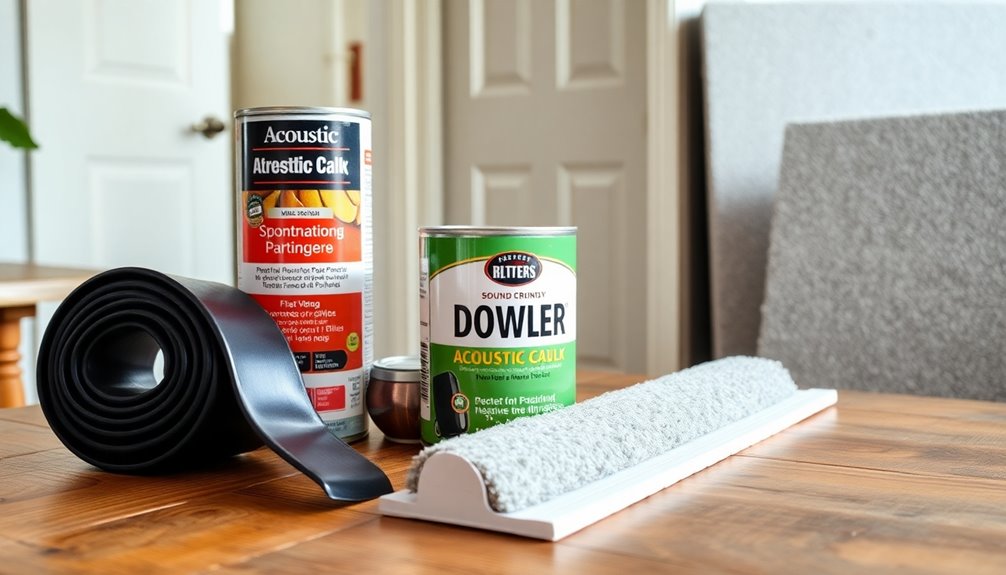
Soundproofing your doors doesn't have to break the bank. There are several cost-effective methods you can use to create a soundproof door and greatly reduce noise.
Here are some practical solutions to evaluate:
- Weather stripping: Seal the door frame to prevent sound leakage. Even small air gaps can compromise your efforts. Additionally, using sustainable materials for weather stripping can enhance your eco-friendly home improvement efforts. Incorporating eco-friendly practices not only helps with soundproofing but also contributes to a more sustainable living environment.
- Solid core doors: If you're in the market for a new door, opt for a solid core instead of a hollow one to enhance sound isolation.
- Mass loaded vinyl (MLV): Apply MLV to your door or surrounding walls. It adds mass without requiring major renovations.
- Door sweeps and thresholds: Install these at the bottom of your door to block sound transmission effectively.
- Acoustic caulk: Use it to seal cracks and gaps around the door frame, helping to maintain your soundproofing efforts.
Additionally, incorporating sustainable practices in your home improvement projects can further enhance your overall living environment while being budget-conscious.
Tools for Sealing Doors
To effectively seal your doors, you'll want to gather essential materials like weather stripping and acoustic caulk. These tools not only help block sound but are also easy to install yourself. Additionally, using eco-friendly materials can further enhance your project's sustainability and align with sustainable fashion practices. Budget apps can also assist you in managing costs during your soundproofing project. For example, apps like YNAB (You Need a Budget) can help you track your expenses and prioritize your soundproofing budget effectively. Let's explore some DIY techniques to make your soundproofing project both effective and affordable.
Essential Sealing Materials
When it comes to sealing doors and minimizing noise transmission, utilizing essential sealing materials can make a considerable difference.
To effectively reduce sound leakage, consider these key materials that won't break the bank:
- Weather stripping: This affordable option seals gaps around your doors, preventing sound waves from leaking through cracks.
- Door sweeps: Installing these at the bottom of your doors eliminates gaps, providing a tight seal that enhances soundproofing.
- Acoustic caulk: Specifically designed for filling gaps between door frames and walls, acoustic caulk guarantees a more airtight seal.
- Jamb seals: Made from sound-absorbing neoprene rubber, these create tight seals at the sides and top of doors, contributing to overall sound insulation.
- Combination use: Utilizing a mix of these sealing materials can considerably improve your soundproofing results while staying within budget.
DIY Installation Techniques
Installing sealing materials is a straightforward way to enhance your door's soundproofing capabilities. Start by checking for gaps and cracks around the door frame. A high-quality weather stripping material can effectively seal these openings, greatly reducing sound transmission.
For the bottom of the door, install a door sweep, which creates a tight seal and minimizes outside noise intrusion.
Next, use acoustic caulk to fill in any remaining gaps and cracks. This flexible sealant absorbs sound waves, preventing leakage and further enhancing soundproofing a door.
If you encounter larger gaps, expanding foam is a great option, as it provides a dense barrier against noise while also improving thermal insulation.
For added mass and sound blocking, consider applying a layer of mass-loaded vinyl (MLV) directly onto the door. When installed properly, this material can dramatically improve sound insulation.
Enhancing Door Mass and Density
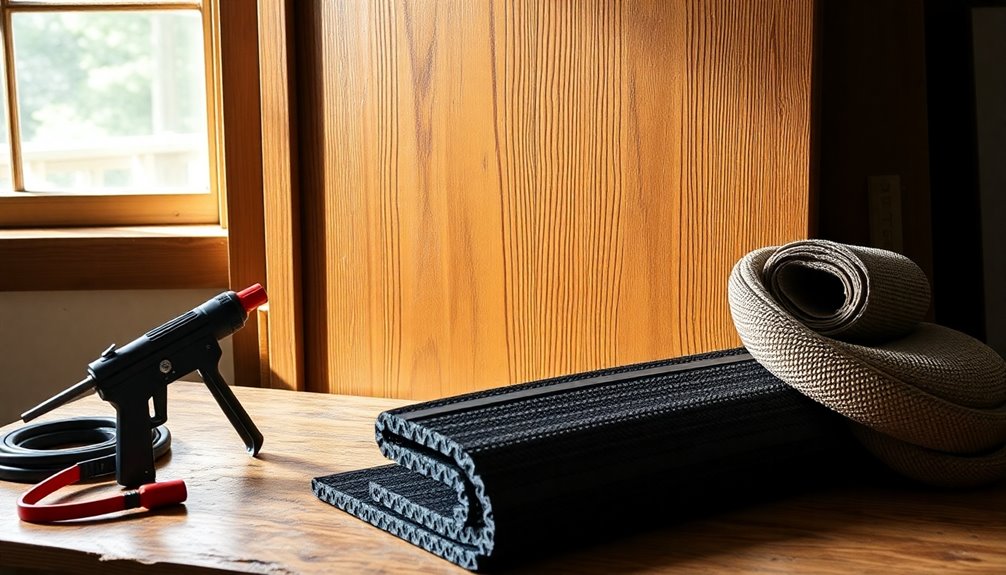
Enhancing the mass and density of your door is a crucial step in effective soundproofing. By doing so, you greatly reduce sound transmission, making your space quieter and more comfortable. AI-driven personalization can also provide tailored recommendations for the best materials suited for your specific soundproofing needs. Additionally, employing accurate categorization in your financial management can ensure you allocate enough budget for soundproofing materials.
Here are some strategies to bear in mind:
- Install solid core doors, as they offer up to 25-30% better sound insulation than hollow core doors.
- Apply mass-loaded vinyl (MLV) sheets to your door; these can block up to 95% of sound transmission.
- Layer additional materials like plywood or heavy blankets to further increase the door's mass.
- Make certain that the door frame is sealed properly to prevent sound leaks; using acoustic caulk is a great way to fill any gaps.
- Remember the mass law principle: doubling the mass of the door can increase sound insulation by approximately 6 dB. Additionally, implementing loyalty programs can enhance customer retention and encourage brand advocacy, similar to how enhancing door mass improves soundproofing.
Using Acoustic Caulk Effectively
Sealing gaps and cracks around your door with acoustic caulk can considerably boost your soundproofing efforts. This specialized caulk is designed to remain flexible, allowing it to effectively fill those pesky openings in door frames and edges.
When installed properly, it can reduce sound leakage by up to 50%.
To get the best results, make sure the surfaces are clean and dry before application. Using a damp finger or spatula, tool the caulk for a smooth finish that enhances the seal.
It's crucial to choose a caulk rated for acoustical use, as this guarantees effectiveness in soundproofing applications. Look for products tested for Sound Transmission Class (STC) ratings to make certain of quality. Additionally, maintaining a centralized system for tracking bills can help ensure you don't overlook the costs associated with soundproofing projects.
Installing Weatherstripping and Sweeps
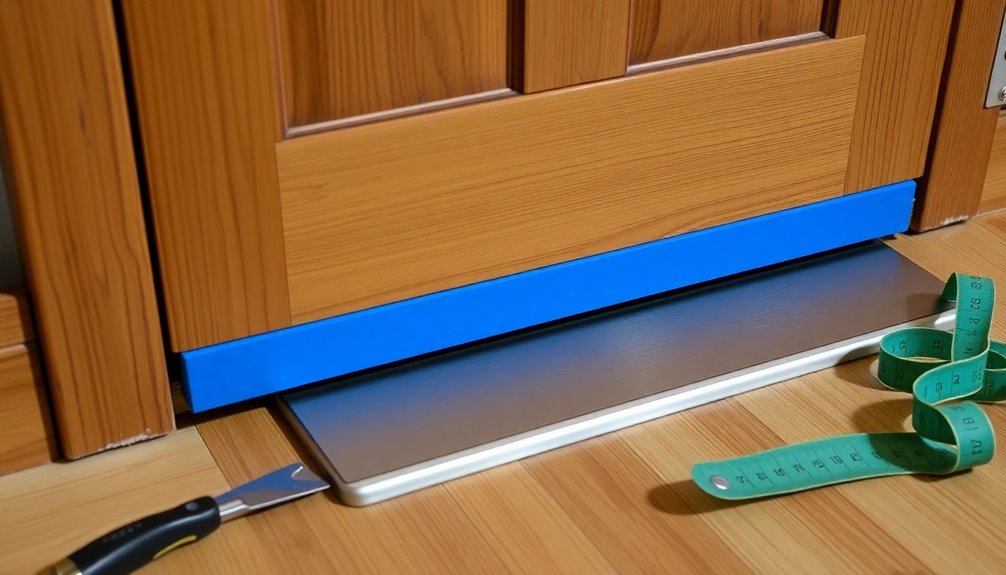
When it comes to soundproofing your doors, selecting the right weatherstripping material is key to blocking unwanted noise.
You'll also want to install door sweeps effectively to seal the gap at the bottom, ensuring a tight fit.
Don't forget to regularly check and maintain these seals, as wear can compromise their soundproofing capabilities.
Selecting Appropriate Weatherstripping Material
Choosing the right weatherstripping material is vital for effective soundproofing around your doors. The right choice can greatly reduce sound transmission, creating a quieter environment in your home. Here are some popular materials to keep in mind:
- Foam: A cost-effective option for sealing minor air leaks.
- Vinyl: Durable and resistant to wear, ideal for long-term use.
- Rubber: Offers excellent sealing properties and longevity.
- Bristle: Often used in door sweeps to block sound at the bottom.
- Magnetic strips: Great for metal doors, providing a tight seal.
When selecting weatherstripping, make sure it fits snugly in the gaps around your door frame. Proper installation involves cleaning the frame thoroughly, measuring accurately, and cutting the material to size.
A tight seal not only blocks noise but also improves energy efficiency by preventing drafts. Additionally, keep in mind that regular maintenance is important; inspect your weatherstripping and sweeps every few years and replace them as needed.
Installing Door Sweeps Effectively
A well-installed door sweep can make a noticeable difference in reducing noise in your home. Start by measuring the gap between the bottom of your door and the floor; this will help you choose the right size door sweep.
Make sure you select a high-quality door sweep, ideally made from materials like high-density foam or neoprene, as they provide superior soundproofing compared to standard options.
Next, install the door sweep according to the manufacturer's instructions. A tight fit is essential—any gaps left can allow sound to seep through, negating your efforts.
Once the door sweep is in place, it's time to turn your attention to weatherstripping. Apply it around the sides and top of the door frame to seal any air gaps that might let sound escape.
Maintaining Seal Integrity Over Time
After ensuring your door sweeps are properly installed, maintaining the integrity of those seals is key to effective soundproofing. To achieve this, focus on the following strategies:
- Install weatherstripping around the entire perimeter of your door frame to minimize gaps. Even a 1% gap can cut soundproofing effectiveness by 50%.
- Choose durable materials like neoprene or foam for your weatherstripping; these can withstand wear and tear while keeping a tight seal over time.
- Regularly inspect and replace weatherstripping and door sweeps every 6 to 12 months. Temperature fluctuations and frequent use can degrade them.
- Consider installing an automatic door sweep. This enhances seal integrity by ensuring the bottom of the door is tightly sealed against the floor when closed.
- Before applying weatherstripping, properly caulk any gaps or cracks in the door frame. This further enhances the seal and prevents sound leakage.
Benefits of Door Seal Kits
When it comes to enhancing your home's soundproofing, door seal kits offer impressive benefits that you won't want to overlook. These kits provide thorough sealing on all four sides of your door, greatly reducing sound leakage and boosting soundproofing effectiveness.
By utilizing neoprene rubber for jamb seals, you create tight seals at the sides and top of your doors, which is essential for minimizing noise transmission.
One standout feature of many door seal kits is the automatic door bottom. This mechanism lowers neoprene seals against the floor when the door is closed, ensuring a snug fit that effectively blocks sound from entering or exiting the room.
Investing in a quality door seal kit can improve sound insulation by up to 50%, making it a cost-effective solution for enhancing your acoustic comfort.
Moreover, many door seal kits are designed for easy installation, so you can achieve considerable soundproofing improvements without the need to hire professionals.
This means you can take control of your space and create a quieter environment with minimal effort and expense.
DIY Soundproofing Techniques
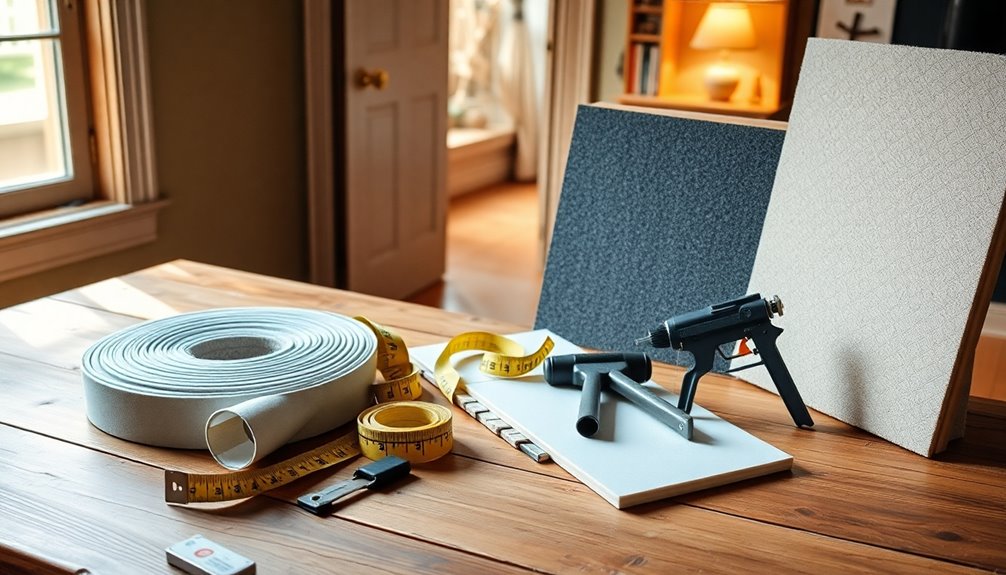
Enhancing soundproofing in your home doesn't have to be an intimidating task. With a few simple DIY techniques, you can considerably reduce noise without breaking the bank.
Here are some effective methods to take into account:
- Install weather stripping: This affordable solution seals gaps around your door, minimizing sound leakage through cracks and openings.
- Add a door sweep: By placing a door sweep at the bottom, you'll create a tight seal that effectively blocks noise from entering through the gap.
- Use mass-loaded vinyl (MLV): This additional layer increases your door's mass, improving sound blocking capabilities without a high expense.
- Apply acoustic caulk: Fill gaps between the door frames and walls with acoustic caulk to guarantee your soundproofing materials remain sealed and effective over time.
- Hang heavy curtains or soundproofing blankets: This quick and budget-friendly method absorbs sound and reduces noise transmission.
Maintenance for Soundproofed Doors
To keep your soundproofed doors effective, regular maintenance is essential. Start by inspecting your door frame for any cracks or gaps. Even small openings can let noise seep through, undermining your soundproofing efforts.
Next, pay attention to your door seals and weather stripping. Check them for signs of wear, and replace them promptly to maintain a tight seal that prevents sound transmission.
Don't forget to schedule routine checks on the alignment of door sweeps and thresholds. Misalignment can create gaps that compromise your soundproofing. If you notice any issues, adjust them immediately.
It's also wise to keep acoustic caulk on hand. This handy material allows you to fill any new gaps or cracks that may develop over time, ensuring your soundproofing remains intact.
Lastly, make sure any soundproofing materials you've installed, like mass loaded vinyl or door sweeps, are properly maintained. Re-secure them as needed to retain their acoustic properties.
Resources for Further Guidance
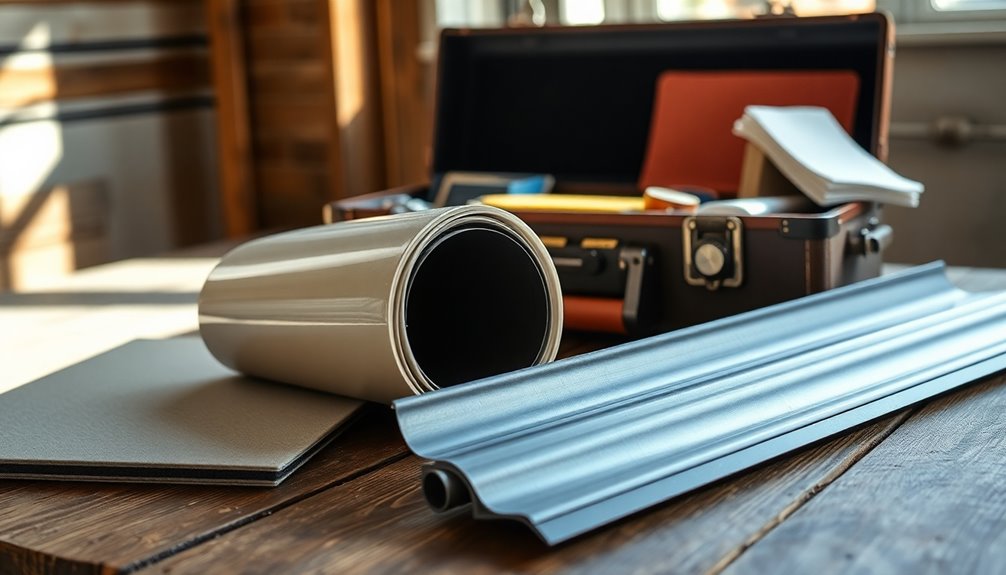
When you're looking for more information on soundproofing doors, online communities and forums can be invaluable.
You can connect with others who share their experiences and tips, helping you avoid common pitfalls.
Additionally, expert soundproofing guides offer detailed insights that can enhance your DIY projects.
Online Communities and Forums
How can you tap into the wealth of knowledge found in online communities and forums for soundproofing doors? These platforms are treasure troves for budget-friendly soundproofing solutions.
By joining discussions, you'll gain access to a wealth of personal experiences and expert advice. Here's what you can expect:
- DIY Techniques: Discover effective methods for soundproofing doors that won't drain your wallet.
- Product Recommendations: Members share detailed reviews of cost-effective materials and tools.
- Troubleshooting Tips: Find threads that tackle common soundproofing challenges, allowing you to seek help from experienced users.
- Networking Opportunities: Connect with industry professionals and enthusiasts who can offer valuable insights.
- Community Support: Engage with others who share your goal of achieving a quieter space, providing motivation and inspiration.
Expert Soundproofing Guides
Tapping into expert soundproofing guides can greatly enhance your efforts in achieving quieter spaces. For budget-conscious individuals, Rod Gervais' book is a treasure trove of cost-effective designs for soundproof doors.
It'll help you understand the principles behind blocking noise without breaking the bank.
Additionally, John H. Brandt provides DIY designs that empower you to implement effective soundproofing solutions tailored to your needs. You don't have to spend a fortune; these guides focus on practicality and good design.
Online communities like Gearspace are also invaluable resources. They allow you to connect with others who've tackled similar challenges, sharing experiences and advice on budget-friendly soundproofing techniques.
You'll find industry experts discussing affordable products and methods that can fit your specific situation.
Conclusion
By investing a little time and effort into soundproofing your doors, you're building a fortress of tranquility in your home. Each tool and technique you apply adds another layer of protection against the chaos outside, creating a serene retreat just for you. Remember, even on a budget, you can achieve a peaceful haven. So roll up your sleeves, embrace the process, and let the soothing silence wrap around you like a warm, comforting blanket.

